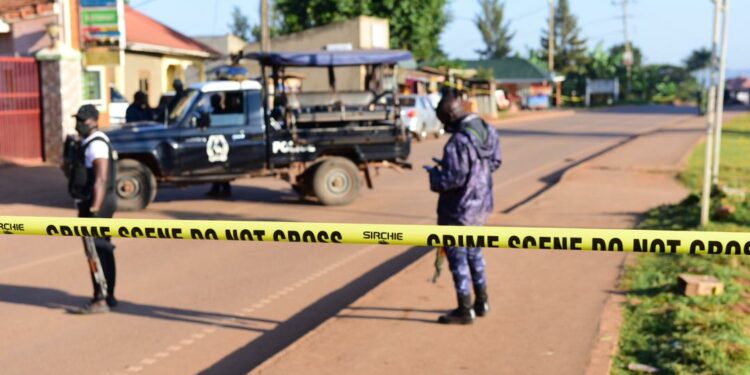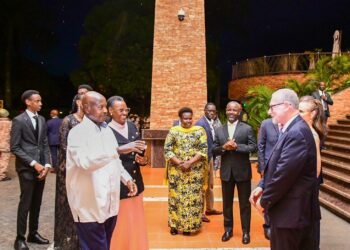The Saturday bomb explosion at pork joint in Komamboga will serve to freshen up the memories of the July 2010 Kampala Bombing at the World Cup final where the mass loss of lives was witnessed.
On a fateful night, about 2100hrs, a bomb exploded at the pork joint as attendants planned to wind up the business. It should be observed, bars are not allowed to operate under the partial lockdown announced by President Museveni. Also, curfew still stands at 7pm.
However, at least two people were reported to have died on spot with scores rushed to Mulago Referal Hospital with grave injuries, after assailants targeted pork and beer takers at the popular hang out on the outskirts of Kampala city.
Although police said it was investigating to conclusively establish the explosion was a bomb, eyewitness accounts point to a possible elementary bomb material after a survivor- a waitress at the joint said the suspected bomb material had been placed in a beer bottle and wrapped up in a black polythene paper.
For now, the pertinent question will center on who is behind the attack?
Just last week, the government of the United Kingdom had warned its citizens in Uganda to be on alert over a possible suicide attack on the country.
Sections of the public have since come out to castigate the Uganda Police Force, and her sister security agencies for not doing enough to prevent the attack by acting on the UK intel.
That said, grounds seem strongly laid to connect the assailants to terrorism. But which terrorist group is really behind the attack.
In the last couple of months, the country has witnessed a spate of insecurity connected to terror actions according to security reports.
On May 1, former Army Commander, and Works and Transport Minister was attacked around the same area of last night’s bombing, surviving with fatal injuries, while her daughter and a driver died on spot.
In August, a suspected suicide bomber had targeted mourners at the burial of former Deputy Inspector General of Police (D/IGP) General Paul Lokech. The assailant’s plans were thwarted and he was captured alive.
Just last month, another terror suspect who had been working closely with the one arrested over the Lokech burial bombing plans was arrested in Kampala and killed while on a mission to assassinate a prominent politician in the capital. Police did not name the politician.
In greater Masaka, the months July and August have been ones to forget for the residents.
At least 27 people were hacked to death using rudimentary tools like iron bars, machetes, arrows, and spears.
Security deployed heavily in the area, with Minister for the Presidency Milly Babalanda, and his counterpart for security Jim Muhwezi among the key cabinet members who camped in the sub-region amid concerted efforts to stamp out the crisis.
By the time the crisis subsided, questions about who was behind the horrific attack on the vulnerable elderly Madakans were left behind.
In all the scenarios, President Museveni has variously claimed the ‘pigs’ connected to the rebel ‘Allied Democratic Forces’ are behind the terror attacks in the country.
At the burial of fallen police chief – Lokech, Museveni said ADF terrorists had targeted the mourners to revenge the deceased’s indefatigable fight against them as they failed to defeat him in life.
He reiterated his determination to deploy a military expedition to flush out the stubborn remnants of the rebel outfit after the arrest of its supreme leader – Jamil Mukulu who up to now continues to battle a string of terror-related charges in Kampala.
The Alshabab, who are responsible for the July 2010 twin bombings in Kampala can also not be ruled out while trying to figure out culprits for the Saturday bomb attack at Komamboga.
For her role in protecting the Somalian Government from the Alshabab Terrorists barked forces under the African Union Mission in Somalia (AMISON), Uganda has always been a target for revenge by the Mogadishu Terror outfit.
Uganda forms the biggest part of the AMISON Contingent in Somalia and is considered a great factor in keeping the Alshabab at bay in Mogadishu. This makes it highly likely that the attack could have originated from the troubled Horn of Africa.
The fact that one of the assailants, according to the account of an eyewitness was dressed in People Power branded colours raises a debate on whether the attack was locally, and politically motivated.
A waiter at the pub told the media that one of the suspected assailants had appeared donned in outfits branded with a NUP emblem and that he was a familiar face seen at the pub before.
At the moment, two influential members of the NUP top leadership are in prison held in connection to the terror attacks in Masaka. These include Mohamad Ssegirinya and Allan Ssewanyana, both MPs for Kawempe North and Makindye West respectively.
Could the Komamboga pork bombing be an internal machination?
Yet Rwanda is another candidate on the list worth scrutinizing. At loggerheads with Uganda for some time now, reports of the south Western neighbor’s hand in supporting subversive activities against her sister have been all over the media. Reports on the infiltration of the Ugandan security organs in what the Head of State called ” Kawukumi in police” have been read and heard on many occasions.
For over two years now, the Rwandan borders remain closed to Ugandan merchandise, with president Paul Kagame further warning its nationals against crossing to the Ugandan side, with scores of both Rwandans and Ugandans shot dead while attempting to illegally move across borders.
The debate on who could be behind the Komambiga attack is expected to be a long and tiresome one, especially as no particular group has since come out to claim responsibility for the offensive. Not until that happens, or security comes out with a comprehensive investigative report, many questions will continue lingering in the minds of the public.
Do you have a story in your community or an opinion to share with us: Email us at editorial@watchdoguganda.com













